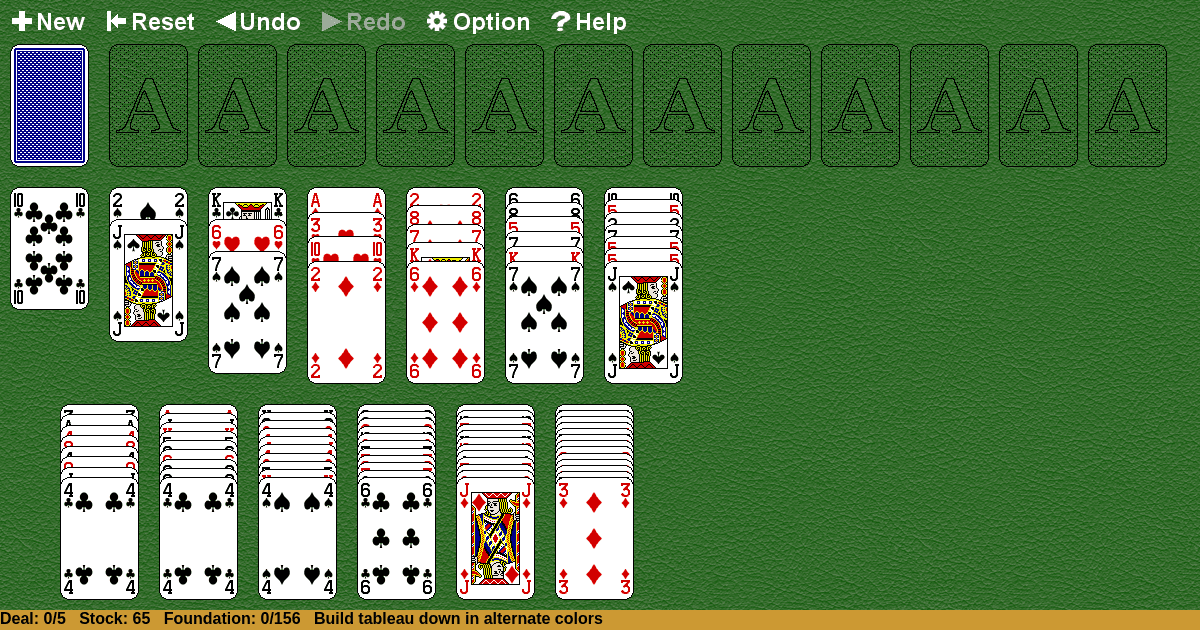Triple Triangle
Home |
How to play |
FAQ |
About
How to play Triple Triangle?
Game Objective:
The primary goal in Triple Triangle Solitaire is to move all cards from the tableau (arranged in three overlapping triangular “peaks”) to the foundation pile (discard pile) by playing cards in sequential order, one rank higher or lower than the current foundation card.
Setup & Layout:
- Deck: Use a standard 52-card deck (no jokers).
- Tableau (Triple Peaks):
- Arrange the tableau into three overlapping triangles (“peaks”).
- Each peak is constructed as follows:
- Place 1 card face down at the apex of each triangle.
- Place 2 face-down cards beneath each apex, slightly overlapping.
- Place 3 face-down cards beneath the previous row, again overlapping.
- Continue until there are 4 rows per peak, with the bottom row consisting of 3 face-up cards per peak.
- The bottom row of the tableau (across all three peaks) consists of 10 face-up cards, each not overlapped by any other card.
- All other cards in the tableau are dealt face down, except the bottom row, which is dealt face up.
- Stock: The remaining cards after building the tableau form the stock pile, placed face down below the tableau.
- Foundation (Discard Pile): Start with the top card of the stock flipped face up to begin the foundation/discard pile.
Key Play Areas:
- Tableau: The three triangular peaks of overlapping cards.
- Stock: The unused cards from the deck, face down.
- Foundation/Discard Pile: The pile where cards are played in sequence.
Triple Triangle Solitaire Rules:
- Card Movement:
- You may move any face-up, uncovered card from the tableau to the foundation pile if it is one rank higher or lower than the current top card of the foundation pile (e.g., play a 7 on a 6 or 8).
- Aces are both high and low: a King may be played on an Ace, and an Ace may be played on a King (“round the corner”).
- Uncovering Cards:
- When a face-down card in the tableau is no longer overlapped by any other card, it is immediately turned face up and becomes available for play.
- Stock Usage:
- If no moves are available from the tableau, flip the top card from the stock onto the foundation pile to change the active card.
- Sequence Building:
- There is no restriction by suit or color; only rank adjacency matters.
- Only one card at a time can be moved from the tableau to the foundation pile.
Gameplay:
- Player Actions:
- Continuously move eligible face-up cards from the tableau to the foundation pile, following the one-rank-up-or-down rule.
- Whenever a card is moved and uncovers a face-down card, immediately turn it face up.
- If no moves are possible, draw the next card from the stock and place it on the foundation pile, then resume playing from the tableau if possible.
- Stock Depletion:
- Once the stock is exhausted and no further moves are possible from the tableau, the game ends.
- No Redeals:
- There is no redeal; you may not reshuffle or reuse the stock once it is depleted.
Winning & Losing Conditions:
- Winning Condition:
- You win by moving all cards from the tableau to the foundation pile before the stock is exhausted.
- Losing/Unwinnable Condition:
- The game is lost if no further moves are possible from the tableau and the stock is empty, with cards remaining in the tableau.
Special Rules & Edge Cases:
- Filling Empty Spaces:
- Empty spaces in the tableau are not filled; once a card is removed from the tableau, it simply leaves an empty spot.
- Multiple Moves:
- Only one card may be moved at a time; sequences cannot be moved together.
- Card Adjacency:
- Only cards that are completely uncovered (not overlapped by any other card) are eligible to be played.
- Ace-King Adjacency:
- The sequence is circular: Kings and Aces are considered adjacent for the purposes of play.
- No Suit or Color Restriction:
- Building is purely by rank, not suit or color.
- Stock Usage Limitation:
- The stock can only be used once, and there is no redeal.
Note:
The above guide is based on the established rules for Tri Peaks Solitaire, which is also known as Triple Triangle Solitaire in some sources. If your variant includes additional unique mechanics, please specify for further clarification.

Solitaire Collection
About Triple Triangle
Rate (Triple Triangle)
4.7 / 5
1,916 votes



























































